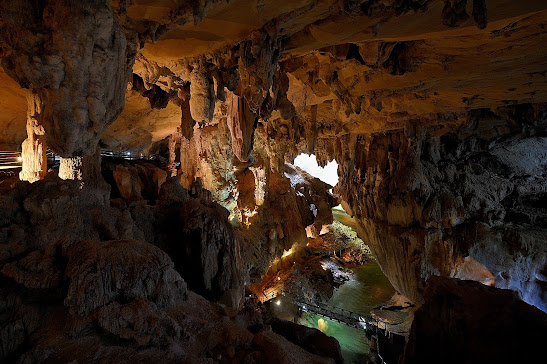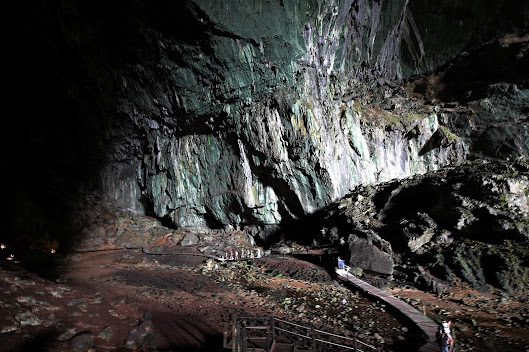Mulu National Park does not require much introduction to the world, especially to those nature lovers and hikers. The park is renowned for its caves exploration, hiking expeditions or simply jungle trekking. It is dominated by three mountains, namely: Mount Mulu, Mount Api and Mount Benarat.
MASWings Turboprop Carrier from Miri to Mulu
Mulu Airport
Entrance to Mulu National Park
The Brief
Mulu National Park is named after Mount Mulu or Gunung Mulu in local Malay language, which is the second highest mountain in Sarawak. The Park covers approximately 53,000 hectar or 530 kilometer square. It is the largest national park open to tourists in Sarawak. In year 2000 the park was formally declared a UNESCO World Heritage site.
The Park is situated in Mulu village. A small village inhabited by few different tribes and indigenous groups, including Penan, Orang Ulu, Kiput, Kenyah, Kayan, Mulut and Berawan.
Sarawak government has appointed two separate organizations to manage the Park. The Sarawak Forestry Corporation is responsible to manage the wilderness zone which covers 90 percent of the area. The tourism zone is managed by Borsarmulu Park Management, who is responsible for providing development supports programme, operation and maintanance activities of the park.
Suspension Bridge Leading to the National Park
Park Welcome Center
UNESCO World Heritage Site Signage
UNESCO World Heritage Site Signage
Directional Signages in the Park
Attractions in Mulu National Park
The main attractions in Mulu National Park are caves, limestone mountains, flora and fauna located in one of the most dense tropical rainforest in South East Asia.
The Park has recorded thousands species of invertebrates, hundreds species of mammals, birds and reptiles. At the same time, it is home to thousands species of flora.
Cave Exploration
Cave exploration is another must-do activity while in the Park. There are four caves open to public, namely Deer Cave, Lang's Cave, Clear Water and Wind Cave. Deer Cave and Lang's Cave are two adjacent caves located in the southern part of park office whilst Clear Water and Wind Cave another two adjacent caves located in the northen part of the park office.
The two caves in the south can be reached by foot along a broadwalk in approximately 1 hour for a distance of 3.8 km one way. The tours to the southern caves are arranged in the afternoon around 2.00 p.m. as bats exodus is awaiting visitors during dusk, right after the cave exploration. This extraordinary natural phenomenon can be withnessed at a bat observatory area in front of Deer Cave.
As for the other two caves in the north, Clear Water and Wind Cave, they can be reached by boat in approximately 30 minutes. Tours to these caves usually arranged in the morning around 9.00 a.m. where the boat stops in the native villages along the river.
In addition to these four, there are seven caves available for adventurous cave expedition. All cave explorations can only be done by a guided tour. You may contact the park office for exact timing of the tours, cost and availability.
Main Boat Pier in the Park
Main Boat Pier in the Park
Boat Trip along the River to the Clear Water and Wind Cave
River at the Entrance to the Clear Water Cave
Steep Climb Leading to the Clear Water Cave
Entrance of Clear Water Cave
Inside Clear Water Cave
Inside Clear Water Cave
Inside Clear Water Cave
River along the Broadwalk Leading to Deer Cave and Lang's Cave
Broadwalk Leading to Deer Cave and Lang's Cave
Broadwalk Leading to Deer Cave and Lang's Cave
Bat Observatory Area in Front of Deer Cave.
Entrance to the Deer Cave and Lang's Cave
Inside the Lang's Cave
Inside the Lang's Cave
Inside the Lang's Cave
Inside the Lang's Cave
Inside the Deer Cave
Mulu Pinnacles Climb
Pinnacles climb is yet another must-do activities for hikers while in the park. It is a high risk and extreme activity organized by the park in a three days two nights trip.
The climb starts in the morning from the Park Welcome Center with half an hour boat ride to reach a village called Kuala Litut. From here climbers need to walk approximately 2 hours for a distance of 9 km to reach Camp 5 where climbers to stay overnight. Camp 5 is the basecamp with a capacity of 38 guests where climbers stay before and after the climb. The following morning around 7 a.m. journey to conquer the pinnacles begins for approximately 4 hours climb to reach the Pinnacles for a distance of 2.4 km through steep steps and dangerous climb. The descend starts right after admiration of magnificent view of the Pinnacles and photo sessions which may take 5 hours back to Camp 5 where climbers stay another night. Next morning around 9 a.m. climbers start the 9 km walking journey back to Kuala Litut where the boat is waiting heading back to Park Welcome Center.
Detail information of the climb, cost and itinerary can be obtained at the park office. To avoid disappointment, prior booking ought to be arranged.
Mulu Pinnacles
How to Get There
The gateway to Mulu National Park is only by air, be it from Miri, Kuching or Kota Kinabalu, Sabah which is operated by a single airline; MASwings, a subsidiary of Malaysian Airline.
For International visitors, certain international flights fly directly to Kuching in Sawarak or to Kota Kinabalu in Sabah, both are in the island of Borneo. Alternatively, you have to transit in Kuala Lumpur. For local Malaysian, direct flights to Miri are available from different cities in Malaysia, namely Kuala Lumpur, Penang, Johor Bahru, Kota Kinabalu and Kuching.
The flight to Mulu takes approximately 30 minutes from Miri, 1 hour 20 minutes from Kuching and 55 minutes from Kota Kinabalu respectively. It takes only 15 minutes drive from Mulu small airport to Mulu National Park.
Much Smaller MASWings Turboprop Carrier from Mulu to Miri
What to Expect
Although Mulu is a small village, it is visited by thousands of visitors, both local and international throughout the year. There are sufficient accommodations available, ranging from air-conditioned bungalows to shared hostel facilities in the Park.
Outside the park, from a luxury Marriott Resort to a standard bed and breakfast homestays are available. As for food, there are number of local eateries nearby at a very reasonable price. Alternatively, get the local to provide food during your stay.
Outside the park, from a luxury Marriott Resort to a standard bed and breakfast homestays are available. As for food, there are number of local eateries nearby at a very reasonable price. Alternatively, get the local to provide food during your stay.
Another consideration is transportation. The best way to move around Mulu villages is by renting motorcycle or car from the local. However, do agree on the price prior to accepting the services to avoid misunderstanding and disappointment.
Boat ride is another alternative for exploring caves or visiting indigenous tribes who live along the river. It can be taken from inside Mulu National Park for a small fee.
Potential Challenges
Due to its remote location and it covers by thick rainforest, do allow flexible itinerary and allow more transit duration especially during rainy season where flight delays and cancellation are often experienced.
The airline, MASwings will not be responsible for any cost if delay and cancellation of flights are caused by weather. As such, travel insurance may be required especially for international travellers. However, it is responsible for accommodation and food for any cancellation due to technical problems of the planes which are also experienced.
Since Mulu is served by 72 seater turboprop carrier or smaller, the seats are limited especially during peak season, from June to September, earlier ticket booking should be done to avoid disappointment. The same goes to the Park arrangement which includes accommodation, hiking and trekking.
Best Time to Visit The Park
Mulu National Park is a tropical destination. The temperature is ranging from 25 to 30 degrees centigrade throughout the year with high humidity and frequent rainfall.
Dry season is from June to September making it the perfect time to visit the Park with less likely of any flight delay and cancellation. The same goes to hiking and exploring caves. However, the park is opened throughout the year.
What to Prepare for the Trip
For non Pinnacle climbers, light clothing and confortable walking shoes are preferred due to hot and humid weather. Raincoat or umbrella, torchlight, hat, waterproof bag for handphone and passport, insect repellent may be required.
For Pinnacle climbers, good hiking shoes and suitable hiking attire are must-have for this activity. However, no hiking stick is allowed in the climb. Other items, including raincoat or umbrella, torchlight, hat, waterproof bag for handphone and passport, insect repellent, slippers may be required. Other necessities including sleeping bag and mosquito nets are available for rent at the camp.
For photography enthusiasts, camera with suitable interchangeable lens is preferred. This may include general purpose lens, super wide angle lens to be used inside the caves and macro lens.
Unfortunately, no tripod is allowed to be used inside the caves for reasons best known to the Park Management. Although such ruling is no where stated in the park's rules. This is the main disadvantage to photography enthusiasts as with the present lighting condition inside the caves, it is almost impossible to have useable photos even with the latest state-of-the-art photography equipment. Hence, we hereby appeal to the Park Management to allow tripod to be used inside the caves as long as it does not hinder the movement of other visitors.






























Wowww Borneo trip. All the best👍🏼👍🏼
ReplyDeleteMany thanks dear friend. It was fascinating.
Delete